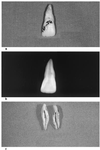Molecular identification by "suicide PCR" of Yersinia pestis as the agent of medieval black death
- PMID: 11058154
- PMCID: PMC18844
- DOI: 10.1073/pnas.220225197
Molecular identification by "suicide PCR" of Yersinia pestis as the agent of medieval black death
Abstract
Medieval Black Death is believed to have killed up to one-third of the Western European population during the 14th century. It was identified as plague at this time, but recently the causative organism was debated because no definitive evidence has been obtained to confirm the role of Yersinia pestis as the agent of plague. We obtained the teeth of a child and two adults from a 14th century grave in France, disrupted them to obtain the pulp, and applied the new "suicide PCR" protocol in which the primers are used only once. There were no positive controls: Neither Yersinia nor Yersinia DNA were introduced in the laboratory. A negative result is followed by a new test using other primers; a positive result is followed by sequencing. The second and third primer pair used, coding for a part of the pla gene, generated amplicons whose sequence confirmed that it was Y. pestis in 1 tooth from the child and 19/19 teeth from the adults. Negative controls were negative. Attempts to detect the putative alternative etiologic agents Bacillus anthracis and Rickettsia prowazekii failed. Suicide PCR avoids any risk of contamination as it uses a single-shot primer-its specificity is absolute. We believe that we can end the controversy: Medieval Black Death was plague.
Figures




References
-
- Ziegler P. The Black Death. Wolfeboro Falls, NH: Alan Sutton Publishing Inc.; 1991.
-
- Derbes V J. J Am Med Assoc. 1966;19:179–182.
-
- Yersin A. Ann Inst Pasteur. 1894;8:428–430.
-
- Slack P. Trans R Soc Trop Med Hyg. 1989;83:461–463. - PubMed
Publication types
MeSH terms
Substances
Associated data
- Actions
- Actions
- Actions
LinkOut - more resources
Full Text Sources
Other Literature Sources
Medical

